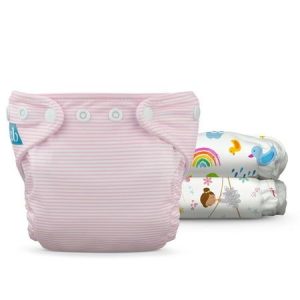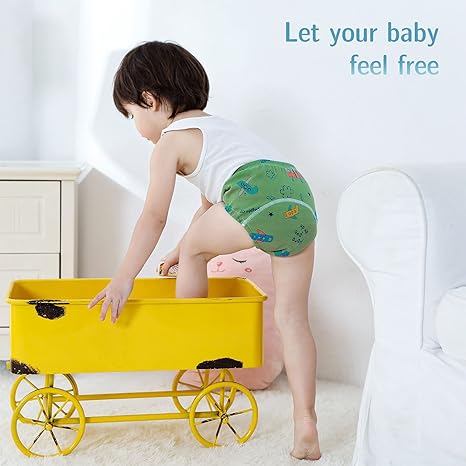Cloth diapering can seem daunting at first, but it’s a rewarding and eco-friendly choice for many parents. This comprehensive guide will walk you through everything you need to know to get started with cloth diapering your baby.
What Are Cloth Diapers?
Cloth diapers are reusable diapers made from fabric instead of disposable ones. They come in a variety of styles, materials, and absorbency levels. Here’s a quick overview:
Prefolds and Flats:
These are rectangular pieces of fabric that require folding or wrapping around the baby and securing with a diaper cover.
Pocket Diapers:
These have a waterproof outer shell with a separate absorbent insert that goes inside a pocket.
All-in-One (AIO) Diapers:
These are the simplest type. They’re one piece diapers that function similarly to disposable diapers.
There are also fitted diapers and diaper covers that can be used with various inserts.
Benefits of Cloth Diapering
Cloth diapering offers several advantages over disposable diapers:
Cost-effective: While there’s an initial investment, cloth diapers can save you money in the long run compared to buying disposable diapers for several years.
Environmentally friendly: Cloth diapers produce significantly less waste than disposable diapers, which can take hundreds of years to decompose in landfills.
Gentler on baby’s skin: Cloth diapers are free of harsh chemicals and fragrances that can irritate some babies’ skin.
Snug and leak-proof: Modern cloth diapers are designed to be snug and leak-proof when used correctly.

Drawbacks of Cloth Diapering
It’s important to consider the drawbacks of cloth diapering as well:
Requires more laundry: You’ll obviously be doing more diaper laundry than with disposables.
Preparation and planning: Cloth diapering requires a bit more planning and preparation compared to grabbing disposable diapers.
Learning curve: There’s a learning curve to using cloth diapers effectively, especially for first-time parents.
Despite the drawbacks, many parents find that the benefits of cloth diapering outweigh the challenges.
Getting Started with Cloth Diapering
Here are some steps to get you started with cloth diapering:
Do your research: Learn about the different types of cloth diapers, materials, and washing routines.
Choose your diapers: Decide what type of cloth diapers might work best for you and your baby. Consider factors like your budget, lifestyle, and preferences.
Gather your supplies: You’ll need diapers, diaper covers (if needed), inserts (if needed), a spray bottle for rinsing soiled diapers, and wet bags for storing soiled diapers on the go.
Prepare for laundry: Learn about proper washing routines for cloth diapers. You’ll typically need a separate laundry routine for diapers to prevent staining and ensure hygiene.
There are many resources available online and in libraries to help you learn more about cloth diapering.
Cloth Diapering Tips for Beginners
Here are some tips to make cloth diapering easier for beginners:
Start slowly:
You don’t have to go all-in at once. Start by using cloth diapers part-time and gradually increase as you get comfortable.
Find a routine that works for you:
Experiment with different washing routines to find what works best for your schedule and water usage.
Don’t be afraid to ask for help:
There are many online communities and forums for cloth diapering parents. You can also seek advice from experienced cloth diapering friends or family members.
Embrace the mess:
There will be leaks and messes, especially in the beginning. Stay patient and troubleshoot any fit or absorbency issues.
Cloth diapering can be a fun and rewarding experience. With a little preparation and the right mindset, you can successfully cloth diaper your baby.
Cloth diapering is a personal decision. By weighing the pros and cons and following the tips in this guide, you can decide if cloth diapering is the right choice for you and your family. Whether you choose cloth or disposable diapers, the most important thing is to find a diapering solution that works best for your baby and your lifestyle.
Essential Cloth Diapering Supplies for Beginners
Once you’ve decided to give cloth diapering a try, here are some essential supplies to get you started:
Cloth Diapers: This is the most important element! Choose the type of cloth diapers that best suits your needs and preferences. There are various options available, so refer back to the section on Types of Cloth Diapers to pick your preferred style.
Diaper Liners (Optional): These are disposable liners that catch solid waste and can be thrown away, making diaper changes easier. Biodegradable liners are available if you want an eco-friendly option.
Wet Bags: These are waterproof bags designed to store soiled cloth diapers until you can wash them. They come in various sizes and styles to suit your needs.
Spray Bottle (Optional): A spray bottle filled with clean water can be helpful for rinsing waste off soiled diapers before laundering.
Diaper Pail: A designated pail with a lid is ideal for storing dirty diapers until wash day. Choose one with a ventilated liner to prevent odors.
Remember, the specific supplies you need may vary depending on the type of cloth diapers you choose.
Cloth Diaper Laundry Routine
Washing cloth diapers properly is essential to maintain hygiene and prevent leaks. Here’s a general guideline:
Solid Waste Disposal: Discard or flush solid waste into a toilet. Biodegradable diaper liners can be composted if your local program allows it.
Pre-Rinse: Rinse soiled diapers with clean water using a spray bottle or by dunking them in a designated toilet bowl insert (not the main toilet).
Store in Diaper Pail: Store rinsed diapers in a lidded diaper pail until wash day. The pail should have a ventilated liner to allow airflow and prevent odors.
Wash Routine: Wash diapers every 1-2 days, depending on usage and the number of diapers you have. Check your washing machine’s manual for the appropriate cycle and water temperature. Hot water is typically recommended for cloth diapers.
Detergent: Use a gentle, fragrance-free detergent specifically formulated for cloth diapers. Avoid harsh chemicals, softeners, and bleach, which can damage the diapers’ absorbency.
Drying: Air drying is preferred for cloth diapers, as sunlight has natural bleaching properties. If using a dryer, tumble dry on low heat. Avoid high heat settings or ironing, as they can damage the fabric.
It’s important to consult the specific care instructions that come with your cloth diapers, as there may be variations depending on the material.
Troubleshooting Common Cloth Diapering Issues
Leaks are a common concern for new cloth diapering parents. Here are some troubleshooting tips:
Fit Issues: Ensure a snug but comfortable fit around the legs and waist. Leaks can occur if the diaper is too loose or gapping.
Absorbency: If leaks happen frequently, you might need to adjust the absorbency level by adding more inserts to your pocket diaper.
Washing Routine: An improper washing routine can lead to buildup and reduced absorbency. Double-check your detergent and cycle settings.
Diaper Spray: Not rinsing away all the waste before washing can cause leaks. Make sure you’re adequately rinsing the diapers with clean water.
If you’re still experiencing leaks after troubleshooting, consult your chosen diaper brand’s resources or online cloth diapering communities for further advice.
Conclusion
Cloth diapering can be a rewarding and sustainable choice for many families. With a little preparation and the right guidance, you can navigate the initial learning curve and establish a cloth diapering routine that works for you and your baby.






